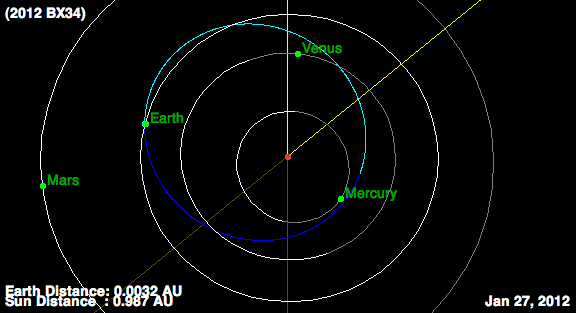Bus-Size Asteroid Buzzes Earth in Close Flyby

This story was updated at 1:02 p.m. ET.
A small asteroid the size of a city bus zoomed between Earth and the moon's orbit Friday (Jan. 27) just days after its discovery, but it never posed a threat to our planet, NASA says.
The asteroid 2012 BX34 passed within 36,750 miles (59,044 kilometers) of Earth when it made its closest approach at 10:30 a.m. EST (1530 GMT). The space rock is about 37 feet (11 meters) wide and would have broken apart in Earth's atmosphere long before it reached the ground, if it had reached the planet at all, NASA scientists said.
"Asteroid 2012 BX34 is small," astronomers with NASA's Asteroid Watch at the Jet Propulsion Laboratory in Pasadena, Calif., said in a Twitter message. "It wouldn't get through our atmosphere intact even if it dared to try."
The space rock passed Earth at a distance that is only about 0.17 times that between the Earth and the moon. For comparison, the moon typically orbits Earth at a distance of about 240,000 miles (386,000 km).
"Asteroids this small are hard to spot, & luckily they pose the least concern," Asteroid Watch scientists explained. "Our goal is to find the bigger ones." [Video and image of asteroid 2012 BX34's orbit]
In September, NASA announced that it has spotted about 90 percent of the largest asteroids (the size of a mountain or bigger) that can come near Earth. About 911 such giant space rocks have been confirmed. Astronomers estimate there are about 981 big near-Earth objects that occasionally creep close to our planet.
Get the Space.com Newsletter
Breaking space news, the latest updates on rocket launches, skywatching events and more!
Asteroid 2012 BX34 was the second space rock to fly relatively close by Earth this week, Asteroid Watch scientists said. On Jan. 23, another small asteroid — called 2012 BS1 — passed by the planet at a range of about 745,000 miles (1.2 million km), which is about 3.1 times the Earth-moon distance.
"Asteroid 2012 BS1 is so small (about 7 meters) it would disintegrate in our atmosphere if it were to come close to Earth," the Asteroid Watch team wrote.
Astronomers with NASA and other science teams routinely scan the skies in search of near-Earth asteroids that could pose a danger to the planet. Experts estimate that asteroids about 460 feet (140 m) across and bigger can cause widespread devastation near their impact sites, though a larger space rock would be required to cause destruction on a global scale.
This week, scientists from around the world are also discussing how Earth should respond to the threat of an asteroid impact. The so-called NEOShield project is a European commission led by the German Aerospace Center and includes scientists from universities and industrial partners in Germany, France, the United Kingdom, Spain, the United States and Russia.
This story was updated to reflect the correct date of the Jan. 27 asteroid flyby.
You can follow Tariq Malik on Twitter @tariqjmalik. Follow SPACE.com for the latest in space science and exploration news on Twitter @Spacedotcom and on Facebook.
Join our Space Forums to keep talking space on the latest missions, night sky and more! And if you have a news tip, correction or comment, let us know at: community@space.com.

Tariq is the Editor-in-Chief of Space.com and joined the team in 2001, first as an intern and staff writer, and later as an editor. He covers human spaceflight, exploration and space science, as well as skywatching and entertainment. He became Space.com's Managing Editor in 2009 and Editor-in-Chief in 2019. Before joining Space.com, Tariq was a staff reporter for The Los Angeles Times covering education and city beats in La Habra, Fullerton and Huntington Beach. In October 2022, Tariq received the Harry Kolcum Award for excellence in space reporting from the National Space Club Florida Committee. He is also an Eagle Scout (yes, he has the Space Exploration merit badge) and went to Space Camp four times as a kid and a fifth time as an adult. He has journalism degrees from the University of Southern California and New York University. You can find Tariq at Space.com and as the co-host to the This Week In Space podcast with space historian Rod Pyle on the TWiT network. To see his latest project, you can follow Tariq on Twitter @tariqjmalik.









